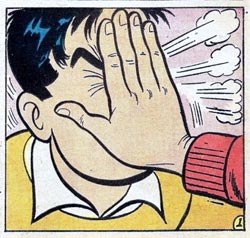
Semantic satiation (also semantic saturation) is a cognitive neuroscience phenomenon in which repetition causes a word or phrase to temporarily lose meaning for the listener, who can only process the speech as repeated meaningless sounds.
{ Wikipedia | Continue reading }
photo { Richard Kern }
Linguistics, photogs | October 23rd, 2009 10:35 am

The experiment was extreme, certainly, but the neuroscientist behind the study, David Eagleman at Baylor College of Medicine in Houston, Texas, is no Dr Strangelove. When we look back at scary situations, they often seem to have occurred in slow motion. Eagleman wanted to know whether the brain’s clock actually accelerates - making external events appear abnormally slow in comparison with the brain’s workings - or whether the slo-mo is just an artefact of our memory.
It’s just one of many mysteries concerning how we experience time that we are only now beginning to crack. “Time,” says Eagleman, “is much weirder than we think it is.”
{ NewScientist | Continue reading }
Another notable difference between sight and hearing concerns space. One of the most striking aspects of visual experience is its rich spatial content. We speak of a visual field, a panorama populated in detail with colours and shapes. In contrast, the notion of an auditory panorama is more foreign. Perhaps time is to audition what space is to vision.
{ Casey O’Callaghan/The Pilosophers’ Magazine | Continue reading }
photo { Josef Hoflehner | via A Photography Blog }
ideas, noise and signals, time | October 23rd, 2009 9:48 am

As most of you know, Cracked.com is actually my night job. My real job is, and has been for the last several years, Chief Editor in Chief at O’Brien & “Sons” Erotic Fiction Publishing House. (…) I’m going to list all the important steps to writing great Erotic Fiction, everything that separates the un-publishable from the publishable. (…)
I can’t tell you how many times I’ve rejected the same, stale Erotic Fiction premises (EroFicPre). A pizza delivery guy enters and seduces with a housewife. A rich prince sweeps a poor, delicate woman off of her feet and into his bed. A painter is so overcome with the beauty of his model that he abruptly stops his work and romances her/masturbates in front of her. A vampire and the twins from that Harry Potter movie fuck in a cave, somewhere. A stale premise won’t get your foot in the door, which is why originality is the single most important part of Erotic Fiction.
The Erotic Fiction Community (EroFicCom) is overrun with these premises. Surprise us!
At the zoo!
Well, I normally only fuck tigers, but I think I can make an exception for a beautiful lady.
Erotic science fiction?
Laser sounds! Laser sounds!
“Be Warned, Earth Woman, the Gargamite invasion is upon us!”
Laser sounds, a spaceship.
“Their air is toxic to us, please allow me to insert the antidote all up in your ass!”
Ass laser sounds!
{ Daniel O’Brien/Cracked | Continue reading }
books, haha, sex-oriented | October 23rd, 2009 9:40 am

We can’t quantify a wine by trying to listen to our tongue. This is because what we experience is not what we sense. Rather, experience is what happens when our senses are interpreted by our subjective brain, which brings to the moment its entire library of personal memories and idiosyncratic desires. As the philosopher Donald Davidson argued, it is ultimately impossible to distinguish between a subjective contribution to knowledge that comes from our selves (what he calls our “scheme”) and an objective contribution that comes from the outside world (”the content”). Instead, in Davidson’s influential epistemology, the “organizing system and something waiting to be organized” are hopelessly interdependent. Without our subjectivity we could never decipher our sensations, and without our sensations we would have nothing to be subjective about.
{ The Frontal Cortex/ScienceBlogs | Continue reading }
photo { Katerina Jebb }
ideas, science | October 23rd, 2009 9:22 am

Critics of zoos usually compare them to prisons. Ralph R. Acampora, an associate professor of philosophy at Hofstra University, thinks zoo confinement is closer to pornography. “Both participants in pornography and inhabitants of zoos are slaves to other people’s desire for viewing, for sight,” he explains. All “have their real nature concealed through their exposure,” with zoo animals “reduced to their shapes or colors or stereotypical behaviors.”
{ The Chronicle of Higher Education | Continue reading }
photo { Garry Winogrand, Central Park Zoo, New York, 1967 }
animals, ideas | October 23rd, 2009 9:14 am

In our contemporary ‘information age’, information and the body stand in a new, peculiar, and ambiguous relationship to one another. Information is plumbed from the body but treated as separate from it, facilitating, as Irma van der Ploeg has suggested, the creation of a separate virtual ‘body-as-information’ that has affected the very ontology of the body.
This ‘informatization of the body’ has been both spurred and enabled by surveillance techniques that create, depend upon, and manipulate virtual bodies for a variety of predictive purposes, including social control and marketing. While, as some feminist critics have suggested, there appears to be potential for information technologies to liberate us from oppressive ideological models, surveillance techniques, themselves so intimately tied to information systems, put normative pressure on non-normative bodies and practices, such as those of queer and genderqueer subjects. Ultimately, predictive surveillance is based in an innately conservative epistemology, and the intertwining of information systems with surveillance undermines any liberatory effect of the former.
{ Surveillance, Gender, and the Virtual Body in the Information Age | Full Text | More: Surveillance & Society, Vol 6, No 4 (2009)
photo { Arno Bani }
ideas, technology | October 17th, 2009 6:20 pm

Super Freakonomics is getting a lot of flak for its flip contrarianism on climate change, most of which seems based on incorrectly believing solar panels are black (they’re blue, and this has surprisingly large energy implications) and misquoting important climate scientists.
{ Washington Post | Continue reading }
At first glance, what it looks like is that Levitt and Dubner have fallen into the trap of counterintuitiveness. For a long time, there’s been an accepted way for commentators on politics and to some extent economics to distinguish themselves: by shocking the bourgeoisie, in ways that of course aren’t really dangerous. Ann Coulter is making sense! Bush is good for the environment! You get the idea.
Clever snark like this can get you a long way in career terms — but the trick is knowing when to stop.
{ Paul Krugman/NY Times | Continue reading }
update:
They have given the impression that we are global-warming deniers of the worst sort, and that our analysis of the issue is ideological and unscientific. Most gravely, we stand accused of misrepresenting the views of one of the most respected climate scientists on the scene, whom we interviewed extensively. If everything they said was actually true, it would indeed be a damning indictment. But it’s not.
{ Freakonomics/NY Times | Continue reading | Also: Superfreakingmeta }
photo { Grant Cornett }
quote { Marx & Engels on Skepticism & Praxis: Selected Quotations }
unrelated { A new short novel from Don DeLillo is scheduled to appear in February, 2010, entitled Point Omega }
books | October 17th, 2009 6:07 pm

The amount of stress we endure is increasing because of our focus on efficiency. Stress is caused by uncertainty, more specifically, by doubts in our ability to handle something. As machines and computers handle more things that are predictable and certain, we are pressured to deal with more things that are unpredictable and uncertain. This inevitably leads to more stress. As soon as our tasks become predictable and certain, we automate them using our technology. The result of this process of streamlining is that we are increasingly called upon to use our, what I would call, irrational abilities, such as instincts, sensibilities, creativities, and interpersonal skills. These things are, by nature, unpredictable.
Take stock trading, for instance. When there were no computers to process the trades, the number of trades you could do in a day was limited. A certain amount of your work as a trader involved processing of paperwork, communicating with others, and doing some arithmetic; tasks that are predictable and not stressful. Today, a click of a button essentially takes care of all of those predictable tasks, and you skip right ahead to another stressful decision-making.
As another example, take graphic designers. Now with computers handling everything from typesetting, layout, image processing, color management to printing, what used to be done by several specialists are now combined into one person. The number of jobs one can handle in a year increased dramatically. Now designers spend more time being creative, and less time creating the final products. This may sound good, but in terms of stress and rewards, it is not. Because creativity is irrational and unpredictable, coming up with a creative solution can be highly stressful. Designers now have to come up with significantly more creative solutions per year for the same amount of money.
{ Dyske Suematsu | Continue reading }
ideas | October 17th, 2009 5:00 pm

When we say someone is a warm person, we do not mean that they are running a fever. When we describe an issue as weighty, we have not actually used a scale to determine this. And when we say a piece of news is hard to swallow, no one assumes we have tried unsuccessfully to eat it.
These phrases are metaphorical–they use concrete objects and qualities to describe abstractions like kindness or importance or difficulty–and we use them and their like so often that we hardly notice them. For most people, metaphor, like simile or synecdoche, is a term inflicted upon them in high school English class: “all the world’s a stage,” “a house divided against itself cannot stand,” Gatsby’s fellow dreamers are “boats against the current, borne back ceaselessly into the past.” Metaphors are literary creations–good ones help us see the world anew, in fresh and interesting ways, the rest are simply cliches: a test is a piece of cake, a completed task is a load off one’s back, a momentary difficulty is a speed bump.
Metaphors are primarily thought of as tools for talking and writing–out of inspiration or out of laziness, we distill emotions and thoughts into the language of the tangible world. We use metaphors to make sense to one another.
Now, however, a new group of people has started to take an intense interest in metaphors: psychologists. Drawing on philosophy and linguistics, cognitive scientists have begun to see the basic metaphors that we use all the time not just as turns of phrase, but as keys to the structure of thought. (…) Metaphors aren’t just how we talk and write, they’re how we think.
{ Boston Globe | Continue reading }
related { Temperature affects how we perceive relationships }
Linguistics | October 17th, 2009 4:59 pm

What special affinities appeared to him to exist between the moon and woman?
Her antiquity in preceding and surviving successive tellurian generations: her nocturnal predominance: her satellitic dependence: her luminary reflection: her constancy under all her phases, rising, and setting by her appointed times, waxing and waning: the forced invariability of her aspect: her indeterminate response to inaffirmative interrogation: her potency over effluent and refluent waters: her power to enamour, to mortify, to invest with beauty, to render insane, to incite to and aid delinquency: the tranquil inscrutability of her visage: the terribility of her isolated dominant implacable resplendent propinquity: her omens of tempest and of calm: the stimulation of her light, her motion and her presence: the admonition of her craters, her arid seas, her silence: her splendour, when visible: her attraction, when invisible.
{ James Joyce, Ulysses, Episode 17 | Continue reading }
photo { Marcus Ohlsson | S magazine }
James Joyce, archives | October 9th, 2009 10:45 pm

One reason that real violence looks so ugly is because we have been exposed to so much mythical violence. (…) Contemporary film style may give many people the sense that entertainment violence is, if anything, too realistic. Nothing could be farther from the truth. … [They] miss the most important dynamics of violence: that it starts from confrontational tension and fear, that most of the time it is bluster, and that the circumstances that allow this tension to be over come lead to violence that is more ugly than entertaining. (…)
A second myth is that fights are long. (…) Whereas most film and stage dramas compress real time to gloss over the dull and routine moments of ordinary life, they expand fighting time by many times over. (…) In reality, most serious fights on the individual or small-group level are extremely short.
{ Randall Collins | via OvercomingBias | Continue reading }
archives, ideas, incidents | October 9th, 2009 4:55 pm












